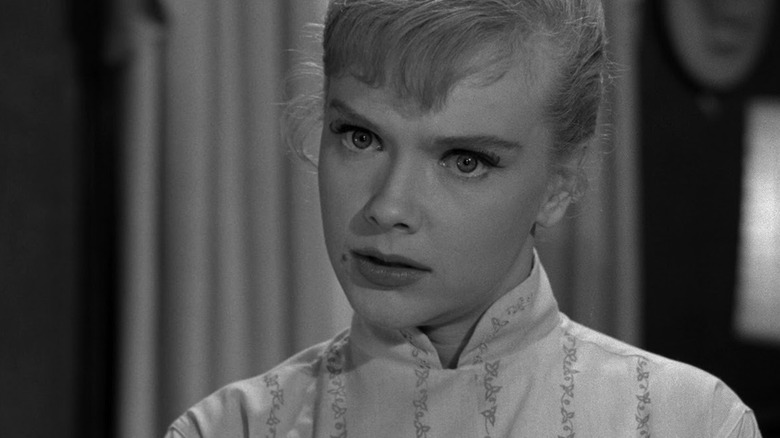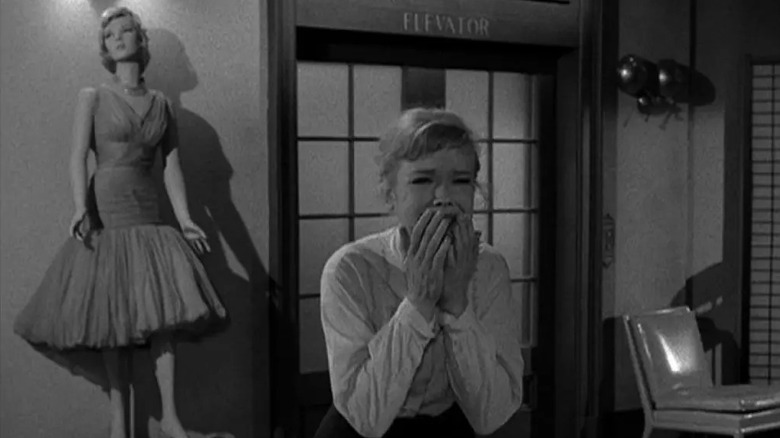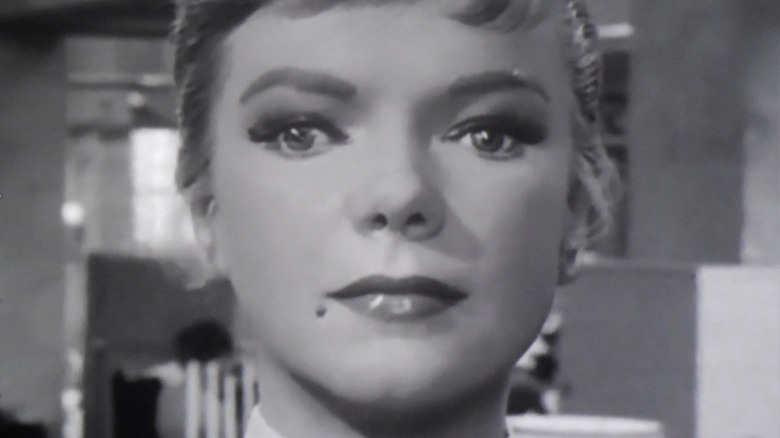One Twilight Zone Episode Harnessed The Same Horror As Five Nights At Freddy's
Emma Tammi's new horror film "Five Nights at Freddy's," based on a popular series of video games, posits that the animatronic animal band from a local chain of pizza palaces is secretly coming to life at night and stalking the palace's night watchman. A puffy, friendly, anthropomorphic bear becomes a bloodthirsty murderer, haunted by the ghosts of children who have secretly died on the pizza restaurant's premises. The animatronic band at Showbiz Pizza, later Chuck E. Cheese's, was considered greatly unnerving to many children, and it doesn't take a very large cognitive leap to imagine the band members stepping off the stage of their own demonic volition, eager to eat the children in their company.
A fear of fake people, of animatronics, and of mannequins, however, goes back many years prior to the inception of "Five Nights at Freddy's," or even the Rock-afire Explosion (the name of the Showbiz Pizza band). Indeed, one can see the germ of such fears in a first season episode of "The Twilight Zone" called "The After Hours," a creepy episode set in a department store where the mannequins may be coming to life.
In "Hours," Anne Francis stars as a fashionable young woman named Marsha, in a department store shopping for a thimble. She is taken to the ninth floor of the building to find the item, even though the building only has eight floors ordinarily accessed by the public. She seeks to complain about the bizarre experience she is having but finds that the people she should be interacting with, including the elevator operator, are becoming mannequins. The store closes. She's locked inside. With the mannequins.
There is, of course, a twist ending, but the episode's terror comes from Marsha encountering mannequins ... who are most certainly alive.
The After Hours
Warning: the twist ending will be revealed below.
If one pays attention to such things, one might note that mannequins have evolved over time. Since at least the 1980s, mannequins have become increasingly more abstract. Mannequin faces have become colorless and hairless, their bodies contorted or changed to more effectively display the clothes they were built to sell. In many cases, mannequin bodies have become more organic and varied, giving a consumer a much more realistic view as to what clothes might look like on their bodies. In most cases, mannequin heads are absent entirely. In short, mannequins have become increasingly practical, mere displays for consumer goods.
In 1960, however, when "The After Hours" aired, mannequins were more than mere displays for clothing. The mannequins had hair and faces. They were whole people. Often, they were placed inside large, elaborate, diorama-like displays, seen as a 3-D snapshot of a human being in the midst of some important, relatable activity. Mannequins sold an entire lifestyle, a whole personality. When "Twilight Zone" creator Rod Serling wrote "The After Hours," he wasn't merely riffing on the creepy, lifelike structures of human-shaped mannequins, but tapping into the advertising fantasies that they represent.
When it finally came to the episode's twist ending, it turned a mirror on that notion. As you look into the fantasy world of the mannequin, it, too, is look out on the fantasy world of yours. Mannequins, the episode posits, dream of living our lives just as much as we fantasize about living theirs.
The ending reveals, perhaps predictably, that Marsha is a mannequin herself. Every month, a living mannequin from the department store is allowed to leave and live like a human for a spell. Then they must return to their jobs as mannequins. Marsha forgot.
Making 'The After Hours'
In Marc Scott Zicree's invaluable book "The Twilight Zone Companion," the makers of "The After Hours" recalled some of the challenges they faced shooting the episode. Because Marsha was revealed to be a mannequin, it was necessary to find a mannequin that looked like Anne Francis. There was even some debate as to whether or not Francis herself should play her mannequin self, or if a statue should be built to match her. Ultimately, the latter was chosen, but producer Buck Houghton remembered the backstage debate on the matter. He said:
"I was very concerned about that one being technically good because I felt it would fall right on its face if those models weren't awfully good. And we debated whether to have Anne Francis do it herself in some sort of frozen pose and we talked about waxing her face and doing a lot of things to make her look like a mannequin, but we felt that wouldn't work. I remember going round and round on how to make that so solid that nobody would laugh at it or say, 'Oh, I caught them doing their tricks.'"
The prop-makers ended up making casts of the actors' faces and building mannequins that looked like them. The effect was eerie and uncanny.
The episode's director, Douglas Heyes, also noted in the "Companion" that their department store set was a stroke of luck. A feature film — he doesn't say which one — had just wrapped shooting, and the director was allowed to infiltrate the enormous space before the set was torn down. He converted a massive false newspaper office into an oppressively cavernous shopping space, stressing Marsha's dreamlike isolation. The camera could move more widely and freely.
Many recall "The After Hours" with terror and fondness.


